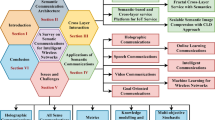Abstract
The distinguished feature of fixed backbone nodes in the wireless mesh networks (WMNs) can be utilized to design an efficient cross layer which cooperates routing and scheduling schemes for increasing end-to-end throughput. With only single radio nodes, by well designing the scheduling and routing schemes for multiple paths, we show that WMN can gain more throughput and reduce communication interference. Much of recent work has focused on those issues applied for “multi-channel, multi-path” environment using multi-radios that is costly and much more complex for implementation. Also, almost all of the proposals work on layer 2 or layer 3 separately that cannot support each other in performing efficiently. Instead, our paper introduces a cross-layer design with new routing algorithm that can balance the numbers of multi-paths and the needed transmission data in each communication session. We also propose a new channel scheduling and queuing models in MAC layer compatible with routing scheme and define a threshold with an effective algorithm to choose the optimal number of disjoint paths for routing scheme. The simulation results show that our multi-path routing scheme performs better than previous proposals in term of throughput improvement which can directly reduce the time of each communication session, especially in case of big size data transmission.















Similar content being viewed by others
References
IEEE802.11 Task Group S http://grouper.ieee.org/groups/802/11/Reports
The Network Simulator—Ns-2 http://www.isi.edu/nsnam/ns/index.html
The Rice University Monarch Project, Mobile Networking Architectures. http://www.monarch.cs.rice.edu
Adya A, Bahl P, Padhye J, Wolman A, Zhou L (2004) A multi-radio unification protocol for IEEE 802.11 wireless networks. In: BROADNETS, pp 344–354
Akyildiz IF, Wang X, Wang W (2005) Wireless mesh networks: a survey. Comput Networks 47(4):445–487
Bahl P, Chandra R, Dunagan J (2004) SSCH: slotted seeded channel hopping for capacity improvement in IEEE 802.11 ad-hoc wireless networks. In: MOBICOM, pp 216–230
Cansever D, Michelson A, Levesque A (1999) Quality of service support in mobile ad-hoc IP networks. In: Military communications conference proceedings, 1999. MILCOM 1999, IEEE, pp 30–34
Couto DSJD, Aguayo D, Bicket JC, Morris R (2003) A high-throughput path metric for multi-hop wireless routing. In: MOBICOM, pp 134–146
Draves R, Padhye J, Zill B (2004) Routing in multi-radio, multi-hop wireless mesh networks. In: MOBICOM, pp 114–128
Goff T, Abu-Ghazaleh NB, Phatak DS, Kahvecioglu R (2001) Preemptive routing in ad hoc networks. In: MOBICOM, pp 43–52
Group IW (1997) Wireless LAN medium access control (MAC) and physical layer (PHY) specifications
Holland G, Vaidya NH, Bahl P (2001) A rate-adaptive MAC protocol for multi-hop wireless networks. In: MOBICOM, pp 236–251
IEEE 802.11. WG, Pa (1999) Wireless LAN medium access control (MAC) and physical layer (PHY) specifications. High-speed Physical Layer in the 5 GHz Band, Standard Specification, IEEE
Johnson DB, Maltz DA (1996) Dynamic source routing in ad hoc wireless networks. In: Imielinski T, Korth HF (eds) Mobile computing, vol 353. Kluwer Academic, Dordrecht. citeseer.ist.psu.edu/johnson96dynamic.html
Keshav S (1991) A control-theoretic approach to flow control. In: SIGCOMM, pp 3–15
Lee S, Gerla M (2001) SMR: split multipath routing with maximally disjoint paths in ad hoc networks. In: ICC
Marina MK, Das MK (2001) On-demand multi path distance vector routing in ad hoc networks. In: ICNP, pp 14–23
Park VD, Corson MS (1997) A highly adaptive distributed routing algorithm for mobile wireless networks. In: INFOCOM, pp 1405–1413
Perkins CE, Belding-Royer EM (1999) Ad-hoc on-demand distance vector routing. In: WMCSA, pp 90–100
So J, Vaidya NH (2004) Multi-channel MAC for ad hoc networks: handling multi-channel hidden terminals using a single transceiver. In: MobiHoc, pp 222–233
Tam WH, Tseng YC (2007) Joint multi-channel link layer and multi-path routing design for wireless mesh networks. In: INFOCOM, pp 2081–2089
Ye Z, Krishnamurthy SV, Tripathi SK (2003) A framework for reliable routing in mobile ad hoc networks. In: INFOCOM
Zhu J, Roy S (2005) 802.11 mesh networks with two-radio access points, vol 5, pp 3609–3615
Author information
Authors and Affiliations
Corresponding author
Rights and permissions
About this article
Cite this article
Trong, H.C., Lee, S. & Hong, C.S. End-to-end throughput improvement for single radio multi-channel multi-path wireless mesh networks: a cross layer design. Ann. Telecommun. 65, 635–646 (2010). https://doi.org/10.1007/s12243-010-0178-y
Received:
Accepted:
Published:
Issue Date:
DOI: https://doi.org/10.1007/s12243-010-0178-y




